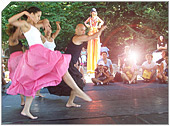Getting Started
Index
NYC Neighborhoods
Manhattan
Brooklyn
Queens
Bronx
Staten Island
NYC Icons
Chrysler Building
Flatiron Building
Empire State Building
Safe NYC
NYPD
FDNY
NYC Weather
NYC Climate
NYC Weather Forecast
Winter Season
Spring Season
Summer Season
Fall Season
NYC History & Politics
New York City History
Tammany Hall and Politics
New York City Politicians
New York City Personalities
Culture of Gotham City
Culture of the city
Cultural diversity
City in popular culture
|
Since its consolidation in 1898, New York City has been a metropolitan municipality with a "strong" mayor-council form of government. The government of New York is more centralized than that of most other U.S. cities. In New York City, the central government is responsible for public education, correctional institutions, libraries, public safety, recreational facilities, sanitation, water supply and welfare services. The mayor and councillors are elected to four-year terms. The New York City Council is a unicameral body consisting of 51 Council members whose districts are defined by geographic population boundaries. The mayor and councilors are limited to two four-year terms.
The mayor is Michael Bloomberg, a former Democrat and current independent elected as a Republican in 2001 and re-elected in 2005 with 59% of the vote. He is known for taking control of the city's education system from the state, rezoning and economic development, sound fiscal management, and aggressive public health policy. In his second term he has made school reform, poverty reduction, and strict gun control central priorities of his administration. Together with Boston mayor Thomas Menino, in 2006 he founded the Mayors Against Illegal Guns Coalition, an organization with the goal of "making the public safer by getting illegal guns off the streets." The Democratic Party holds the majority of public offices. 66% of registered voters in the city are Democrats. New York City has not been won by a Republican in a statewide or presidential election since 1924.Party platforms center on affordable housing, education and economic development, and labor politics are of importance in the city.
New York is the most important source of political fundraising in the United States, as four of the top five zip codes in the nation for political contributions are in Manhattan. The top zip code, 10021 on the Upper East Side, generated the most money for the 2004 presidential campaigns of both George W. Bush and John Kerry. The city has a strong imbalance of payments with the national and state governments. New York City receives 83 cents in services for every $1 it sends to the federal government in taxes (or annually sends $11.4 billion more than it receives back). The city also sends an additional $11 billion more each year to the state of New York than it receives back.
Located near City Hall are the courthouse for the United States District Court for the Southern District of New York and United States Court of Appeals for the Second Circuit, and the Jacob K. Javits Federal Building. Brooklyn hosts the United States District Court for the Eastern District of New York, and each Borough has a branch of the New York Supreme Court and other New York State courts. As the host of the United Nations, New York City is home to the world's largest international consular corps, comprising 122 consulates, consulates general and honorary consulate offices
Tammany Hall
Tammany Hall was the Democratic Party political machine that played a major role in controlling New York City politics from the 1790s to the 1960s. It usually controlled Democratic Party nominations and patronage in Manhattan from the mayoral victory of Fernando Wood in 1854 up to (but not including) the election of Fiorello LaGuardia in 1934, then weakened and collapsed.
|
New York City Search
Quick NYC
|



 New York Weather Forecast
New York Weather Forecast
 Ethnic composition
Ethnic composition


















